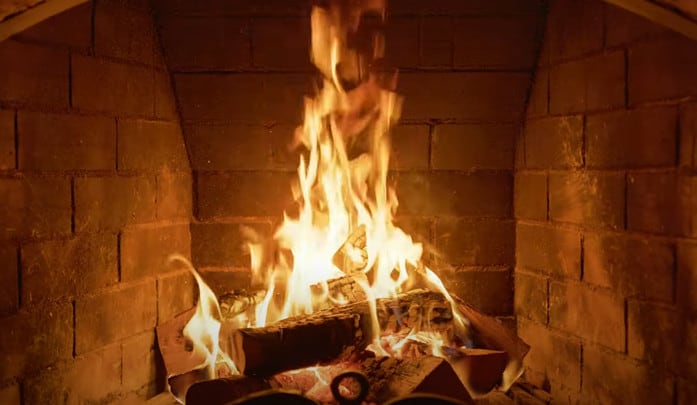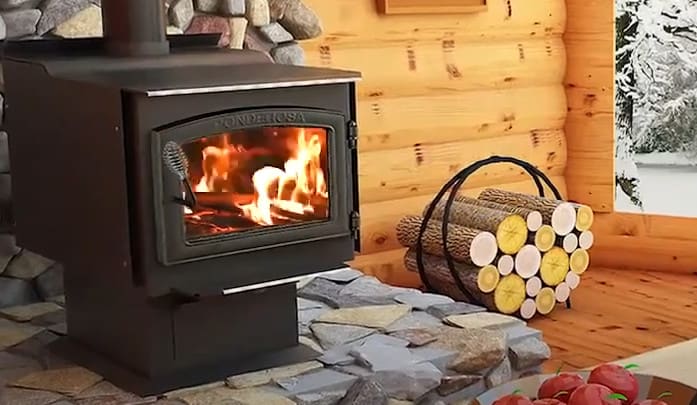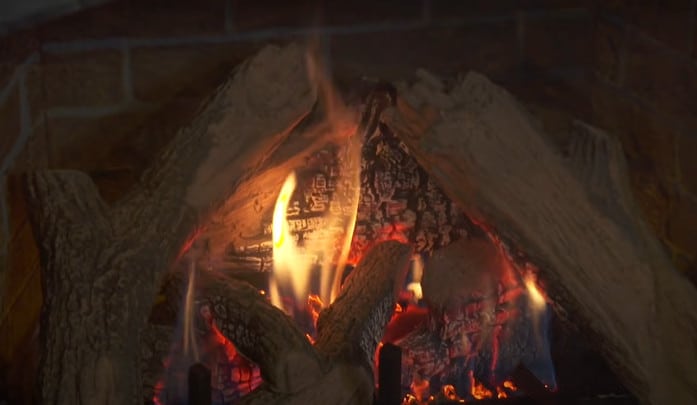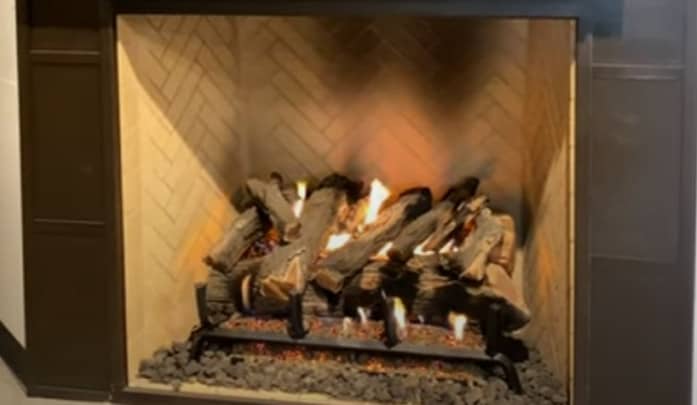It’s always a tricky question when it comes to appliances – is it worth the money? To be honest, when it comes to gas fires there can be definite pros and cons, so it’s essential to do your research before deciding if it’s worth investing in. Today we’re answering the question – are gas fires expensive to run? While this article focuses on gas fires, the principles can also apply to electric fires? It’s an important one to consider, as gas fires can provide excellent heat output, convenient operation and a stunning focal point in your home. But of course, all of this is only worthwhile if it’s going to be cost effective in the long-term. Read on to find out more, and with any luck this post can help clear up some of the confusion and help you make an informed decision. Let’s get started!
The cost of running a gas fire will vary depending on the size, type, and efficiency of the fire. Generally speaking, gas fires are cost efficient to operate as they provide more heat for less money than other heating sources.
“You must factor in both the installation and ongoing fuel costs when contemplating the operating expense of a gas fire. While it varies significantly across geographical locations, on average, a gas fireplace can cost between to per month in the coldest season. Rate variation and the efficiency of your specific fireplace model can affect this cost.”
Stellan Brevik, Heating Technology Specialist
The Cost of a Gas Fire
The cost of running a gas fire varies greatly depending on several factors, including the type of gas fire in question, the structure of its installation and its efficiency. It is an energy-efficient form of heating that requires little maintenance, but it can be expensive to run when compared to other heating solutions.
In general, gas fires are comparatively inexpensive compared to electric or solid fuel options. The cost of running a gas fire can range from being relatively cheap to more costly than any other conventional heating solution. Factors to consider include the cost of gas required to run the appliance and whether it is an open flame or an efficient sealed flue system.
For example, if a household used a standard open-flued natural gas fire, their monthly bills would likely be higher than with a closed flue system that uses a electric spark ignition and modern fuel efficiency features. Furthermore, electric fires are generally cheaper to run as they do not require any fuel for combustion and no chimney for ventilation. Installing the necessary wiring for an electric fire can add up to significant costs, however.
Ultimately, whether or not a gas fire is expensive to run will depend largely upon how efficiently it is installed and how much heat output is desired from the appliance. Gas typically has no additional delivery charges beyond its initial purchase price, making it a potentially attractive choice for many people who wish to maintain low heating costs over time.
On balance though, there are advantages and disadvantages when considering which type of fuel powered heating system is best suited to each individual’s needs. Moving on from this discussion on cost of running a gas fire, we now turn our attention to looking at the initial purchase price…

Purchase Price
When considering whether gas fires are expensive to run, one of the first factors to consider is the purchase price. Most gas fireplaces come with an upfront installation cost, which can be quite costly depending on the size and type of fireplace chosen. A standalone gas fire may end up costing significantly less than a model which requires more complex installation procedures.
On the other hand, when compared to traditional wood burning fires, gas models tend to be much cheaper since they do not require a chimney to be installed or any ongoing maintenance such as cleaning after use. Additionally, investing in a modern gas fire offers both time and money savings in terms of installation costs since the majority of models can now be easily installed by a skilled technician in only a few hours.
Overall, due to lower installation costs and higher efficiency when compared with traditional wood burning fireplaces, gas fires can offer greater value for money for potential buyers. In conclusion, purchasing a gas fire is usually a sensible and economical decision when compared with an open flame fireplace.
Having discussed purchase price it is now important to consider fuel costs when determining whether gas fires are expensive to run. This will be addressed in the following section.
- According to Energy.gov, the average gas fireplace operates at around $0.25-$1.00 per hour of use, depending on how often the pilot light is lit and how long the fire is burning.
- A survey conducted in 2015 found that gas fires can cost significantly less to run than electric fires, with estimated costs ranging from 7p per hour up to 40p per hour in comparison.
- The same survey found that a standard output gas fire can cost 1/3 of what an equivalent electric fire would cost over one year, even when taking into account energy inflation.
Fuel Costs
When it comes to running a gas fire, fuel costs can vary depending on the type of gas used and how frequently it is used. In the UK, natural gas is currently the most popular choice, as it offers a cheaper option compared to bottled gas such as LPG. Natural gas is sold by volume and charged per kilowatt-hour, while LPG is sold by weight and charged per litre.
Gas fire prices also depend on the type of fire being used. For example, open fires are cheaper to run than closed combustion fires as they consume less energy to keep running. Open fires are ideal for those who use them infrequently or want to reduce their carbon footprint. Closed combustion fires usually require more energy and therefore cost more money to run but are often more efficient than an open fire in the long-term when used regularly.
It’s important to factor in that many different factors can affect the cost of running a gas fire, from how well it is maintained to how long it runs for. Regular maintenance of any kind of fireplace will ensure maximum efficiency which can help cut down fuel costs. Additionally, reducing the length of time you use your fireplace in each session will also help save on fuel costs.
At the end of the day, it all comes down to personal preference and budget. With careful consideration of all factors involved, it is possible to control your fuel costs when using a gas fire. This leads us into our next section where we explore the efficiency of a gas fire and how this affects its running costs.
Gas Fire Efficiency
When considering the question “are gas fires expensive to run?” its important to look at their efficiency. Gas fireplaces are generally more efficient than traditional fireplaces, with some models offering a very impressive energy efficiency rating of up to 89%. In comparison to other forms of heating, like electric or oil heaters, most natural gas fires deliver better value for money.
However, there are some drawbacks that need to be considered when looking into a gas fireplace’s overall energy efficiency. Some non-certified natural gas fires can have much lower efficiency ratings and can draw a large amount of energy even when they are not in use. Similarly, gas log burners often have low efficiency ratings as they draw heat away from the room if they are not regularly maintained and serviced.
Ultimately, the answer on whether a gas fire is efficient depends on the specific model you purchase. Doing your research will help you identify which models offer an adequate energy efficiency rating for your needs as well as how much servicing might be required for certain types of fires to maintain their optimal performance.
Now let’s shift our focus to look at how much heat these fires can produce: their heating output.

Heating Output
When considering the efficiency of a gas fire, it is important to consider its heat output. Gas fires are typically more efficient than open-port fireplaces, which allow a great deal of heat to escape up the chimney. Gas fires provide heated air directly into the room and the high efficiency of modern models can mean they produce around 70% energy back as heating. As with any appliance, depending on the age and quality of the model, this level of efficiency can be lower.
When choosing a gas fire, knowing its heat output capacity is also essential. This will tell you how much heat it produces, which helps you determine how powerful the fuel source needs to be to ensure adequate heating levels in your home or facility. Generally speaking, a gas Fire’s heat output levels depend on the size of the burner and the type of fuel used; larger burners with higher calorific values will produce more heat output than smaller ones with lower calorific values. The size of your area also plays a role in deciding how many BTUs (British thermal units) you need from your gas fire to stay comfortable in different weather conditions.
Though gas fires may offer greater efficiency than open-port fireplaces, their environmental impact should not be underestimated. In the next section, we will explore emissions and environmental impact from gas fires in detail.
Emissions and Environment Impact
When it comes to gas fires, the environmental impact must also be taken into account. Gas fire emission levels are dependent on a variety of factors, such as type of burner, installation and the quality of the fuel being used. If a high efficiency burning system is installed, combustion and emissions can be minimized while providing a cost-effective heat source. On the other hand, if an open or low efficiency burning system is used, emissions may be much higher than those with an efficient combustion system.
Additionally, natural gas is considered to be one of the cleanest fossil fuels available in terms of its environmental impacts. It has significantly lower carbon dioxide emissions than more traditional fuels like coal, and fewer hazardous wastes are produced when burned. In fact, the use of natural gas has been found to decrease overall emission levels even further when compared to other forms of energy sources – making it quite desirable for eco-conscious homeowners and businesses alike.
In spite of its positive aspects, burning natural gas can still produce pollutants that can have negative effects on air quality; such as methane, nitrous oxides and carbon dioxide which all contribute to global warming. For this reason, ever stricter regulations are regularly placed on this type of fuel to ensure their safe use and minimal emissions.
It’s clear that gas fires need to be carefully managed in order to minimize their impact on both local and global environments. With careful consideration given to installation accuracy, maintenance requirements and compliant fuel sources there can actually be significant environmental benefits to having a gas fire installed in your home or business premises.
The reliable operation of a gas fire also provides important peace of mind when considering factors such as maintenance and general reliability – these important topics will be discussed further in the next section.
Must-Know Points to Remember
Gas fires have both positive and negative environmental impacts. Using a high efficiency burning system can help to reduce emissions, and natural gas is a relatively clean form of fuel compared to other sources such as coal. However, the burning of natural gas can still produce pollutants that can damage air quality. Careful consideration must be taken when installing and managing a gas fire in order to minimize its environmental impact. In addition, regular maintenance and compliant fuel sources are necessary to ensure reliable operation.
Maintenance and Reliability
Maintaining and ensuring a reliable gas fire can carry some financial costs. You will need to budget for an annual service of your fire, often costing between £60-£150. This check should be carried out by a Gas Safe certified engineer, with any necessary parts or repairs likely to add extra cost. In addition, you may need to replace gas fire components, such as the burner, which can vary in price depending on the type of fire you have installed. It’s also important to note that some gas fires require special ventilation set ups that account for moisture and fumes generated from the appliance and this might include additional installation costs to ensure it complies with regulations.
Overall, when it comes to reliability and maintenance, gas fires generally perform well when correctly installed and serviced. However, owners do have to bear in mind that problems can occur and depending on the age of your appliance; repairs could be costly compared to similar non-gas appliances. On the other hand, more modern gas fires are made with high quality components that require less regular servicing than before and are tested rigorously at manufacturing stages as part of safety regulations.
Now let’s look at alternatives to gas fires if you’re looking for a more affordable or efficient heating solution.

Alternatives to Gas Fires
When it comes to heating a home, gas fires are a popular option. Despite their convenience and efficiency, they can be costly to operate. Fortunately, there are alternatives to gas fires if you are looking for more cost-effective options.
Electric fireplaces provide the same traditional look and ambiance as gas fires with no need for flue installation or running costs. The majority of electric fireplaces allow you to turn them on and off with the click of a button. Electric ones also provide clean air, producing no smoke, soot or ash like their gas counterparts. With modern technology, some electric fireplaces have settings such as flames that repeat and replicate real fires.
On the other hand, traditional wood burning fireplaces have been a source of heat since before the industrial revolution. Wood-burning stoves are highly efficient when compared to closed masonry fireplaces. They are also constructed in such a way that they warm up a room quickly because hot air is naturally drawn around its surface area which is much larger than an equally powerful gas flame. As well as providing an economical solution, wood is also renewable fuel which has become increasingly popular among environmentally conscious homeowners. You might need a reliable torch lighter for this option.
Choosing between different types of heating systems ultimately depends on your specific needs and preferences. It’s important to weigh the pros and cons carefully before making a decision and seek professional advice if needed. This is especially true when considering heating options for specific areas of your home, such as the best way to heat a conservatory. After assessing all of your options and researching their associated costs and benefits, you will be able to make an informed decision regarding the best heating system for your home.
In conclusion, gas fires are an effective form of heating but can be costly to run in comparison with other alternatives such as electric fireplaces or traditional wood burning stoves. In this section we discussed both sides of the argument and outlined some key points in favour of each option for people considering a switch from gas fires in their home. The next section will explore ways in which you can make sure that whatever heating system you choose is energy efficient so stay tuned!
Conclusion
When it comes to the question of whether gas fires are expensive to run, the answer is not a simple yes or no. When used responsibly and in well-ventilated areas, gas fires can be both cost-effective and efficient. However, poor ventilation, improper placement, and outdated gas fires can significantly increase running costs and should be avoided. As with any home heating system, it’s important to thoroughly research the pros and cons of using a gas fire before making your decision.
In terms of cost, electric fires typically range from three to five times more expensive than traditional gas fires. The upfront cost may vary greatly depending on the style of fire opted for, but typically electric models are more costly than gas models due to additional installation requirements.
When considering how much a gas fire will cost you over time, take into account the price of the fuel (including installation fees) plus any maintenance fees associated with its upkeep. Installing an efficient model that’s designed to use less fuel can reduce running costs significantly over the life of the unit. In addition, ensuring there is adequate ventilation in the area reduces potential health risks associated with extreme temperatures or hazardous emissions from burning fuels.
Ultimately, there are both benefits and drawbacks when it comes to choosing between a gas or electric fire for your home heating needs. Electric models tend to have higher upfront costs but often require less maintenance and don’t rely on natural resources like wood or coal. On the other hand, while they generally cost less initially, operating a traditional gas fire may prove much more costly over its lifetime due to higher fuel prices and additional installation fees associated with installing tanks or pipelines. Whichever option you choose, make sure you consider all of your options carefully before making your decision in order to ensure that you get the most value out of your investment.

Answers to Common Questions with Detailed Explanations
Are there any advantages of using a gas fire compared to other heating sources?
Yes, there are several advantages of using a gas fire compared to other heating sources. First, they are more efficient, providing a steady and consistent warmth without having to continuously monitor the temperature. Second, they are also cost-effective to run and can save households money on their energy bills when compared to electric or oil-fired central heating systems. Third, gas fires tend to be much easier to install and maintain than other heating sources and can often be done by amateurs with minimal experience. Finally, the heat from a gas fire is usually immediate, providing quick, comfortable warmth in rooms with no other source of heat.
What factors influence the cost of running a gas fire?
The cost of running a gas fire is determined by a variety of factors, such as the type of gas fire (i.e. traditional, inset, or wall mounted), the gas efficiency rating, the unit’s size and heat output, whether the fire uses an open or closed flue, and local energy costs. Traditional gas fires tend to be less expensive to run than inset or wall-mounted ones. Additionally, most modern models have much higher energy efficiency ratings than their predecessors do, meaning they use less fuel to generate the same amount of heat. The larger the unit and the higher its heat output are, the more fuel it will consume and therefore the more it will cost to run. Likewise, using an open flue can make a gas fire slightly cheaper to operate because it doesn’t require forced ventilation in order to safely draw air for fuel combustion. Finally, regionally-varying energy prices can significantly affect how much your gas fire costs to run in any given month.
What type of gas fire is the most cost-effective to run?
The most cost effective type of gas fire to run is a highly efficient condensing gas fire. These modern gas fires are designed with heat-exchangers that capture and reuse energy, making them incredibly efficient. Not only do they produce more heat for the same amount of fuel, but they also create less emissions meaning you can save money and reduce your environmental impact. Additionally, condensing gas fires require less maintenance due to their sealed combustion system which creates fewer draughts and reduces the risk of carbon monoxide build up.
References
https://verticalchimney.com/blog/gas-fireplace-maintenance/
https://www.familyhandyman.com/project/how-to-install-a-gas-fireplace/





From my personal experience as a consumer analyst, I can tell you that the running costs of gas fires can vary widely based on a number of factors. These factors include the specific model, how often you use it, and utility prices in your area. Remember, the initial cost isn’t the only factor, appliance with lower upfront prices may have higher ongoing costs in terms of maintenance and energy use.
I installed a high-efficiency gas fire in my cabin last winter and found that the ongoing costs were manageable thanks to its optimized fuel use. It’s pertinent to consider your personal usage habits and the energy-efficiency of the model when calculating the potential costs.
Totally concur with you Titus, the model’s energy efficiency plays a significant role, my last purchase was a high-efficiency one too and I’ve seen noticeable drops in my bills.
Giancarlo, same here! I’ve also switched to a high-efficiency gas fire model last winter, and so far, my bills have shown quite a drop too, making it quite cost-effective in the long run.
I concur with you Kinsley, the initial investment may be steep but high-efficiency models are worth it. I have seen my heating bills drop as well after installing gas fireplaces in my living room and bedroom last year.
I find myself agreeing with you Rothman, high-efficiency models certainly have long term benefits in terms of heat output and cost-effectiveness. The upfront procurement and installation costs may be a bit steep but if one can afford it, it’s a prudent investment. I installed a gas fireplace in my home post-retirement and was pleasantly surprised by its efficiency. Furthermore, the aesthetic appeal of the hearth adds quite a touch to my living room ambiance each winter.
I agree with you Warren, high-efficiency models do have appreciable long-term benefits, particularly if well-maintained. From my experience in energy analysis, it’s also worth considering the carbon footprint of gas fireplaces versus other heating methods like electric or wood-burning stoves.